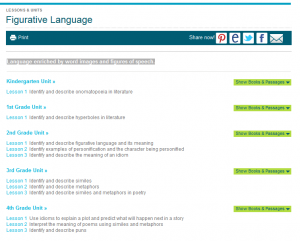Common Core Reading Lessons: Figurative Language

Language enriched by word images and figures of speech.
Figurative Language - Covers kindergarten through sixth grade. Examples: Identify and describe onomatopoeia in literature. Identify and describe hyperboles, idioms, metaphors, and similes in literature. Identify and describe puns.
Presentation of Knowledge and Ideas
CCSS.ELA-Literacy.SL.K.5 Add drawings or other visual displays to descriptions as desired to provide additional detail.
Key Ideas and Details
CCSS.ELA-Literacy.RL.1.1 Ask and answer questions about key details in a text.
CCSS.ELA-Literacy.RL.1.2 Retell stories, including key details, and demonstrate understanding of their central message or lesson.
Integration of Knowledge and Ideas
CCSS.ELA-Literacy.RL.1.7 Use illustrations and details in a story to describe its characters, setting, or events.
Key Ideas and Details
CCSS.ELA-Literacy.RL.2.1 Ask and answer such questions as who, what, where, when, why, and how to demonstrate understanding of key details in a text.
Range of Reading and Level of Text Complexity
CCSS.ELA-Literacy.RL.2.10 By the end of the year, read and comprehend literature, including stories and poetry, in the grades 2-3 text complexity band proficiently, with scaffolding as needed at the high end of the range.
Comprehension and Collaboration
CCSS.ELA-Literacy.SL.2.1 Participate in collaborative conversations with diverse partners about grade 2 topics and texts with peers and adults in small and larger groups.
CCSS.ELA-Literacy.SL.2.1c Ask for clarification and further explanation as needed about the topics and texts under discussion.
CCSS.ELA-Literacy.SL.2.2 Recount or describe key ideas or details from a text read aloud or information presented orally or through other media.
Vocabulary Acquisition and Use
CCSS.ELA-Literacy.L.2.4 Determine or clarify the meaning of unknown and multiple-meaning words and phrases based on grade 2 reading and content, choosing flexibly from an array of strategies.
CCSS.ELA-Literacy.L.2.4a Use sentence-level context as a clue to the meaning of a word or phrase.
CCSS.ELA-Literacy.L.2.5 Demonstrate understanding of word relationships and nuances in word meanings.
CCSS.ELA-Literacy.L.2.5a Identify real-life connections between words and their use (e.g., describe foods that are spicy or juicy).
Craft and Structure
CCSS.ELA-Literacy.RL.3.4 Determine the meaning of words and phrases as they are used in a text, distinguishing literal from nonliteral language.
CCSS.ELA-Literacy.RL.3.5 Refer to parts of stories, dramas, and poems when writing or speaking about a text, using terms such as chapter, scene, and stanza; describe how each successive part builds on earlier sections.
Range of Reading and Level of Text Complexity
CCSS.ELA-Literacy.RL.3.10 By the end of the year, read and comprehend literature, including stories, dramas, and poetry, at the high end of the grades 2-3 text complexity band independently and proficiently.
Fluency
CCSS.ELA-Literacy.RF.3.4 Read with sufficient accuracy and fluency to support comprehension.
CCSS.ELA-Literacy.RF.3.4b Read on-level prose and poetry orally with accuracy, appropriate rate, and expression on successive readings
Vocabulary Acquisition and Use
CCSS.ELA-Literacy.L.4.5 Demonstrate understanding of figurative language, word relationships, and nuances in word meanings.
CCSS.ELA-Literacy.L.4.5b Recognize and explain the meaning of common idioms, adages, and proverbs.
Key Ideas and Details
CCSS.ELA-Literacy.RL.4.1 Refer to details and examples in a text when explaining what the text says explicitly and when drawing inferences from the text.
CCSS.ELA-Literacy.RL.4.2 Determine a theme of a story, drama, or poem from details in the text; summarize the text.
Craft and Structure
CCSS.ELA-Literacy.RL.4.5 Explain major differences between poems, drama, and prose, and refer to the structural elements of poems (e.g., verse, rhythm, meter) and drama (e.g., casts of characters, settings, descriptions, dialogue, stage directions) when writing or speaking about a text.
Range of Reading and Level of Text Complexity
CCSS.ELA-Literacy.RL.4.10 By the end of the year, read and comprehend literature, including stories, dramas, and poetry, in the grades 4-5 text complexity band proficiently, with scaffolding as needed at the high end of the range.
Vocabulary Acquisition and Use
CCSS.ELA-Literacy.L.4.4 Determine or clarify the meaning of unknown and multiple-meaning words and phrases based on grade 4 reading and content, choosing flexibly from a range of strategies.
CCSS.ELA-Literacy.L.4.4a Use context (e.g., definitions, examples, or restatements in text) as a clue to the meaning of a word or phrase.
CCSS.ELA-Literacy.L.4.6 Acquire and use accurately grade-appropriate general academic and domain-specific words and phrases, including those that signal precise actions, emotions, or states of being (e.g., quizzed, whined, stammered) and that are basic to a particular topic (e.g., wildlife, conservation, and endangered when discussing animal preservation).